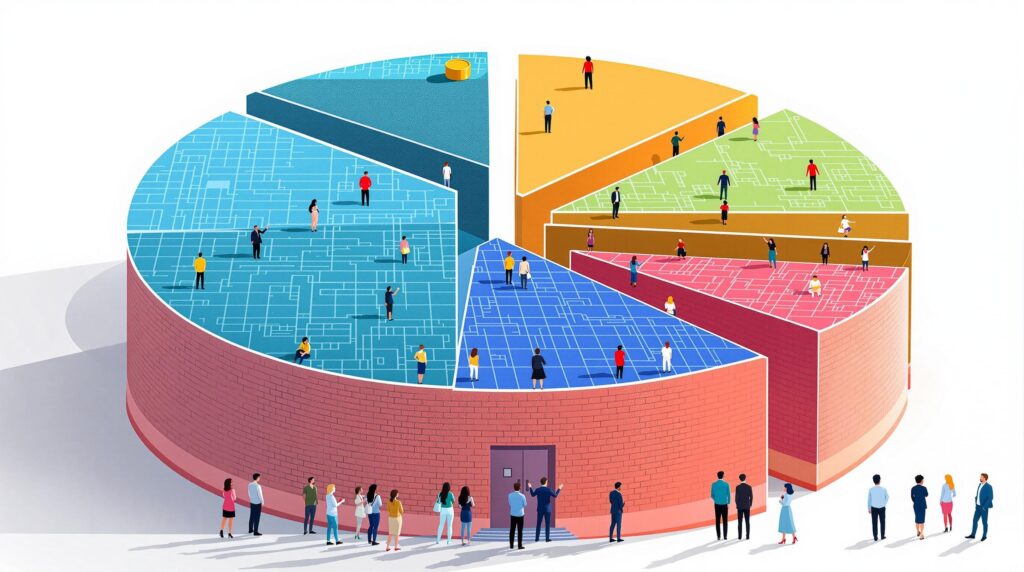[rev_slider alias=”slider-1″][/rev_slider]
Understanding the Blockchain Trilemma
What exactly is the blockchain trilemma? It’s a term that frequently pops up in discussions about blockchain technology. This trilemma revolves around the difficult task of balancing three key components: decentralization, security, and scalability. If you’re diving into the world of cryptocurrencies and blockchain, this concept is essential to grasp. But why is it such a critical challenge?
The blockchain trilemma refers to the challenge of achieving a balanced state among decentralization, security, and scalability within a blockchain network.
Let’s break it down further. In the blockchain universe, decentralization means ensuring that no single entity has control over the entire network. This is crucial for maintaining trust among users. Decentralized networks operate across various nodes, making it difficult for any one party to take over. But here’s the thing: achieving this can often compromise security. Just like in any group project, sometimes having too many voices can lead to chaos instead of cohesion.
Meanwhile, security ensures the protection of data and assets against cyber threats. Enhancing security typically involves a verification process that can slow down transactions. You’ve probably experienced this with websites that have robust security checks—great for safety but could be a patience test!
On the flip side, scalability is all about the network’s capacity to handle an increasing number of transactions. Imagine trying to speed up traffic on a highway; that’s what scalability aims to do for blockchain networks. However, pushing scalability often means sacrifices on the decentralization or security fronts.
Now, how about the significance of the blockchain trilemma for Africa’s burgeoning digital markets? Take Jara, for instance, which is at the forefront of bridging global capital to African assets. By understanding the trilemma, platforms like Jara can tailor their technology to balance these three aspects in ways that best suit Africa’s unique economic landscape.
The trilemma isn’t just a theoretical puzzle; it influences real-world applications, especially in regions like Africa, where the digital economy is exploding. Solving this puzzle decides how effective blockchain technologies can be, providing scalable and secure solutions without compromising on the decentralization that protects user autonomy.
The Role of Layer 1 Blockchains
Architectural Advantages
Layer 1 blockchains are the foundational backbone of the blockchain ecosystem, serving as the primary layer where transactions are recorded. This structural supremacy enables remarkable advantages, particularly when addressing the blockchain trilemma—the challenge of balancing scalability, security, and decentralization. So, what are these architectural advantages that make Layer 1 blockchains indispensable?
Layer 1 blockchains are designed to secure and validate all network transactions directly on the chain, making them fundamental for achieving decentralized, scalable, and secure systems.
One of the core architectural features of Layer 1 blockchains is their ability to handle thousands of transactions per second. This is made possible through distributed ledger technology that ensures every transaction is validated through a consensus mechanism, such as Proof of Work (PoW) or Proof of Stake (PoS). These mechanisms not only fortify the network against attacks but also maintain its openness and decentralized nature.
Scalability: While Layer 2 solutions often build on top of Layer 1 to enhance speed and reduce costs, the base layer’s scalability remains crucial as it dictates the ultimate throughput of the entire network. Techniques like sharding distribute the workload across multiple nodes, increasing transactional capacity without sacrificing decentralization.
Security: A primary advantage of Layer 1 blockchains is their high level of security. Because all nodes participate in securing the network, the system resists collusion and corruption. Enhancements like Byzantine Fault Tolerance (BFT) ensure that networks continue operation even when nodes defect or malfunction.
Decentralization: Unlike traditional centralized systems, Layer 1 blockchains thrive on decentralization, allowing multiple nodes to share consensus responsibility, which ensures that no single entity can control or censor the network. This feature is critical in maintaining the trustless nature that users rely on.
The integrity of Layer 1 blockchains can be compared to building a house’s foundation solidly before adding floors (Layer 2 solutions). Just as a house’s foundation determines the structure’s stability, Layer 1 solutions determine a blockchain ecosystem’s reliability.
The Jara platform utilizes its own proprietary Layer 2 solution to improve on these foundational Layer 1 advantages, ensuring low transaction costs, high-speed processing, and enhanced security, which fosters an optimal environment for Africa’s growing digital asset economy.
Understanding the importance of these foundational advantages is crucial for participants seeking to harness blockchain’s full potential. As Africa continues to digitally transform, with platforms like Jara leading the charge, the region’s integration of robust blockchain solutions is accelerating economic empowerment and access to global marketplaces.
Are Layer 1 blockchains the only solution? While they offer the necessary framework for security and decentralization, the blockchain ecosystem is vast, with each layer offering distinct solutions and enhancements.
| Blockchain Layer | Main Purpose | Applications |
|---|---|---|
| Layer 1 | Core transactional processing and security | Bitcoin, Ethereum (base layer) |
| Layer 2 | Scalability enhancements and faster processing | Lightning Network, Jara’s Caldera-based L2 |
The synergy between these layers allows for continuous improvements and adaptations to meet evolving demands. As the interest in digital infrastructure grows across Africa, platforms utilizing these technologies are primed to lead economic and technological transformation.
Africa’s blockchain landscape is anticipated to flourish as Layer 1 and Layer 2 solutions harmonize, creating a seamless digital environment. This integration is key to bridging the existing infrastructure gap and propelling the continent towards a $200 billion digital economy.
[rev_slider alias=”text-call-cta”][/rev_slider]
Layer 2 Solutions: Complementing Layer 1
Layer 1 blockchains, notably the foundation of blockchain technology, play a critical role in providing security and decentralization. However, as the demand for blockchain applications increases, the pressure on these blockchains also grows, particularly regarding scalability. This is where Layer 2 solutions come into play. By offloading some operations from the main chain, Layer 2 solutions enhance the efficiency and scalability of Layer 1 blockchains, making transactions faster and cheaper without compromising security or decentralization.
Understanding Layer 2 Solutions
Layer 2 solutions are secondary frameworks or protocols built on top of existing blockchains. They aim to improve transaction throughput and reduce congestion on the main blockchain network. Imagine Layer 2 solutions as express lanes for transactions, allowing the main blockchain to handle more significant transactions while the bulk moves through these secondary channels. Two prominent Layer 2 technologies include rollups and plasma, both of which offer unique approaches to scalability.
What are rollups in Layer 2 solutions? Rollups are scaling solutions that execute transactions outside the main chain but post transaction data on the Layer 1 blockchain, ensuring comprehensive security guarantees.
Rollups: Optimizing Efficiency
Rollups stand out as a popular Layer 2 scaling technique. They execute transactions outside the main blockchain but post the data on Layer 1. This ensures that the security and decentralization benefits of the main blockchain are retained while enhancing scalability. There are two types of rollups: optimistic rollups and zk-rollups. Optimistic rollups assume transactions are valid by default, reducing the computational burden, while zk-rollups use zero-knowledge proofs to validate transactions with mathematical certainty, which can be further explored in fraud protection strategies.
Plasma: Enhancing Transaction Speed
Plasma, another Layer 2 solution, involves creating smaller chains connected to the main blockchain. These chains handle transactions and periodically submit them to the main blockchain. This method significantly increases the number of transactions the network can manage, as it offloads much of the transaction work from the main chain. By resolving disputes only on the main chain, plasma ensures that fraud or errors are still checked and corrected. Unlike rollups, whose data remains on Layer 1, plasma manages certain parts of data off-chain, enhancing transaction speed and scalability.
How does plasma work in Layer 2? Plasma functions by forming smaller transaction chains off the main blockchain, handling mass transactions efficiently before summarizing and synchronizing with the core blockchain for finalization.
Layer 2 Benefits for Africa’s Digital Economy
Especially in Africa, where infrastructure gaps and high transaction costs are prevalent, the implementation of Layer 2 solutions could be revolutionary. As Jara builds its proprietary Caldera-based L2 blockchain, it is uniquely poised to bridge these challenges by offering enhanced transaction speeds and reduced costs. The accessibility to investments for everyday individuals would be vastly improved, enabling broader participation in Africa’s growing digital asset economy. Learn how this infrastructure can contribute to improving financial accessibility in the continent by exploring legal implications of economic growth.
The Synergy Between Layer 1 and Layer 2
The synergy between Layer 1 and Layer 2 solutions creates a hybrid eco-system where security and decentralization are maintained while scalability is improved. By utilizing Layer 2, developers can create complex decentralized applications (dApps) that cater to extensive networks without being bogged down by transaction delays or excessive fees. This dual approach ensures that blockchain remains robust and versatile, capable of handling the growing needs of industries, particularly in regions like Africa where innovation meets necessity.
Ultimately, the symbiotic relationship between Layer 1 and Layer 2 solutions offers a comprehensive answer to the blockchain trilemma, addressing scalability, security, and decentralization. As technological advancements continue, the potential for blockchain applications will expand, paving the way for innovation in financial services, supply chain management, and beyond.
“Your Voice, Our Mission” – forward-thinking approaches gelling Layer 1 and Layer 2 technologies are cultivating a robust framework for the blockchain solutions of tomorrow.
Future Prospects of Blockchain Scalability
In the ever-evolving landscape of blockchain technology, scalability continues to be a pivotal challenge. However, as we look towards the future, there are promising innovations emerging on both Layer 1 and Layer 2 solutions that offer potential breakthroughs. These advancements aim not only to enhance efficiency but also ensure the security and decentralization of blockchain systems. Let’s delve into some of the most anticipated innovations in this realm, especially focusing on their applicability to African markets, where blockchain can drive significant growth and inclusion.
Emergence of Sharding Technology
Sharding is one of the most exciting trends in blockchain scalability. But what exactly is sharding?
Sharding is a process that splits the blockchain into smaller, more manageable pieces called “shards” each capable of processing transactions independently.
This reduces the load on individual nodes and enhances the overall capacity of the network. For African markets, this means more efficient processing of transactions, which is crucial for high-volume applications such as financial services and supply chain management.
The integration of sharding can be particularly transformative in regions like Africa, where rapid transaction processing can support the growth of digital economies and overcome infrastructural limitations.
Role of Layer 2 Solutions
Layer 2 solutions, such as rollups and sidechains, offer another avenue for improving blockchain scalability. These solutions operate on top of existing Layer 1 blockchains and are designed to handle transactions off-chain while submitting periodic summaries to the main chain. This approach not only alleviates congestion but also enhances transaction speed and reduces costs.
- Optimistic Rollups: Utilizes the principle of optimistic execution, where transactions are assumed correct for finalization but can be challenged within a specific period if needed.
- ZK Rollups: Employ zero-knowledge proofs to verify and bundle transactions off-chain, while only posting minimal data on-chain, thus ensuring security and privacy.
Both approaches are instrumental in regions like Africa, where transaction costs and speed are critical for businesses and individuals relying on digital currency platforms such as $JARA.
Blockchain Interoperability and Cross-Chain Solutions
As the number of blockchain networks increases, the ability to transfer assets and data seamlessly across different chains becomes more critical. What does blockchain interoperability mean?
Blockchain interoperability refers to the ability of different blockchain systems to communicate and collaborate with each other seamlessly.
Cross-chain solutions are being developed to bridge these networks, facilitating broader access and utility of blockchain resources.
For the African market, where diversity in blockchain usage is growing, interoperability ensures that users can leverage the best features of multiple platforms without being confined to a single network. This is crucial for initiatives such as Jara’s ecosystem, which seeks to integrate various asset types and applications under a unified platform.
Potential for African Markets
Africa presents a unique and burgeoning opportunity for blockchain technology, particularly in overcoming challenges related to scalability. As developers focus on building infrastructure that is resilient and adaptable to regional needs, blockchain can revolutionize sectors such as finance, agriculture, healthcare, and more.
“Africa’s digital revolution is poised to benefit significantly from innovative blockchain solutions, making financial inclusion and economic empowerment reachable goals.” – Jara Technology Insights
By investing in these scalable blockchain technologies, African markets can unlock potential cost savings, enhance transparency, and promote a more inclusive financial ecosystem. The role of tokens like $JARA becomes increasingly vital as they integrate these advanced technologies to create a vibrant and supportive digital economy.
Conclusion: Building a Scalable Future
In conclusion, the future prospects of blockchain scalability are bright, with emerging technologies promising to solve longstanding challenges. As these innovations continue to evolve, their impact on regions like Africa cannot be overstated. By embracing these advancements, the continent can harness the full potential of blockchain to foster economic growth and societal development. Keep an eye on Jara as it leverages these technologies to fuel its mission of transforming Africa’s digital asset landscape.
[rev_slider alias=”schedule-consultation-btn”][/rev_slider]

What challenges do Layer 1 Blockchains solve in the Blockchain Trilemma?
Layer 1 blockchains like Bitcoin and Ethereum tackle the Blockchain Trilemma by providing enhanced security and decentralization, laying the groundwork for subsequent enhancements in scalability.
- Security: Layer 1 blockchains are designed to be secure by default, protecting against unauthorized access and attacks.
- Decentralization: They maintain a decentralized network, ensuring no single entity has control.
How do Layer 1 improvements influence future blockchain developments?
Enhancements in Layer 1 blockchains serve as a robust framework for future technological growth, enabling the development of more sophisticated and efficient systems.
Feel free to explore more resources on how blockchain technology is evolving and contributing to various sectors by reaching out to us through our Contact Page.
Please ensure you integrate this HTML content directly into your WordPress site without additional editing to maintain the structure and formatting. The FAQ section is crafted to answer common and critical questions regarding Layer 1 Blockchains and their impact on the Blockchain Trilemma while also being designed to rank well in search engines.

Related Pages for Blockchain Enthusiasts
Explore more about how various blockchain solutions are paving the way toward solving complex challenges.
Discover What Our Clients Are Saying
At the forefront of our practice is a deep-seated commitment to client satisfaction. Each case is handled with utmost care, as echoed in the appreciative feedback from those we represent.

[rev_slider alias=”slider-3″][/rev_slider]
[rev_slider alias=”slider-6″][/rev_slider]
Connect with Jara: Your Layer 1 Blockchain Experts
At Jara, we understand the intricacies of navigating the blockchain trilemma with Layer 1 solutions. Our innovative approach bridges global capital with African assets, ensuring secure and scalable blockchain systems tailored to your needs.
Don’t just take our word for it. Explore our award-winning service and join us on this revolutionary journey. Reach out via email at [email protected] or discover the future of blockchain technology by downloading the Jara app for Android or iPhone.
“Your Voice, Our Mission” – we champion your rights with the tenacity and dedication that has earned us the trust of our community members.
Awards and Recognitions
- Innovative Blockchain Solution 2023: Recognized by Blockchain Awards for advancing Layer 1 technologies. Explore award details
- Top FinTech Startup 2023: Listed among the best by FinTech Review, highlighting our innovation in bridging financial gaps. Discover more
- Africa’s Blockchain Trailblazer 2023: Highlighted by Tech Africa for our contributions to blockchain solutions across the continent. Learn more
- Best Emerging Fintech Solution 2023: Commended by Financial Focus for our leading-edge approach in fintech applications. See the award
- Outstanding Tech Startup 2023: Featured among the top by Startup Radar for our cutting-edge development in blockchain technology. Get details
With our strategic insights into Layer 1 solutions, we offer unparalleled support tailored to your blockchain needs. Step into the future with Jara and redefine your blockchain journey today.
Chinyere “Chi” Nnadi
Founder and CEO, Jara | Expert in Blockchain Solutions
Content reviewed by Chi Nnadi and his content team. Chi is a visionary entrepreneur striving to revolutionize Africa’s finance through blockchain. As the Founder and CEO of Jara, he leads in converting illiquid African assets into accessible digital tokens using cutting-edge Layer-2 blockchain technology, fostering an inclusive digital market.
















